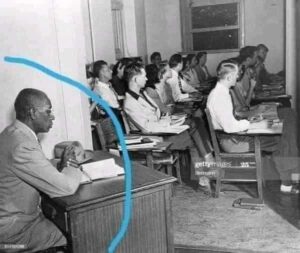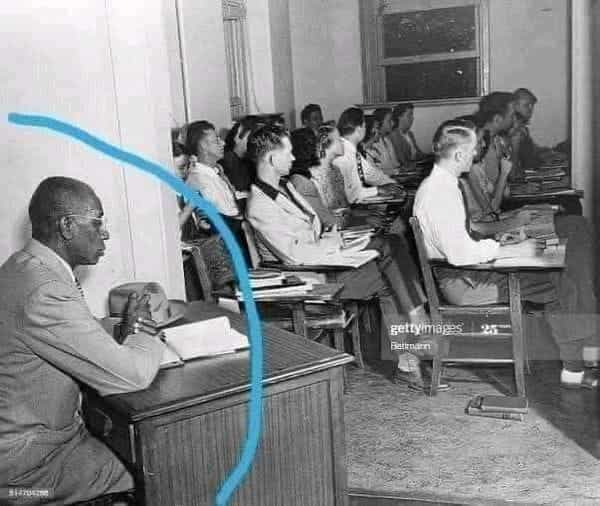George McLaurin, the first Black man admitted to the University of Oklahoma

One in 12,174.
That’s what George McLaurin became Oct. 14, 1948, when he began classes at OU: drifting alone, one dark face in a sea of 12,173 white ones.
George W. McLaurin, an African American educator, became a symbol of resilience and determination during the fight for racial desegregation in American higher education. Born on September 16, 1887, in Guthrie, Oklahoma, McLaurin’s journey from an accomplished teacher to a pivotal figure in civil rights history underscores his profound impact on the educational landscape of the United States. His battle against institutionalized racism, particularly through his landmark legal case against the University of Oklahoma, set a precedent for the integration of public institutions and expanded the boundaries of educational equality.
Early Life and Education
George McLaurin was raised in a time when opportunities for African Americans were severely limited, especially in the realm of education. Despite these obstacles, McLaurin pursued his studies with remarkable determination. He earned a bachelor’s degree from Langston University, Oklahoma’s historically Black college, and went on to obtain a master’s degree in education. His career as an educator was distinguished; he taught at various schools and eventually became a professor at Langston University, where he dedicated himself to uplifting the African American community through education.
The Battle for Admission
In 1948, McLaurin applied for admission to the University of Oklahoma to pursue a doctorate in education. However, Oklahoma’s segregation laws at the time prohibited Black students from attending white institutions. Despite his qualifications, the university initially rejected McLaurin’s application solely based on his race. This denial sparked a legal battle that would have national implications.
With the help of the NAACP Legal Defense Fund and attorney Thurgood Marshall, McLaurin sued the University of Oklahoma, challenging the state’s segregation policies. The case, McLaurin v. Oklahoma State Regents for Higher Education, went all the way to the U.S. Supreme Court. In 1950, the Supreme Court ruled in favor of McLaurin, stating that the university’s segregated policies deprived him of equal protection under the Fourteenth Amendment. This decision was a significant victory, marking a crucial step toward desegregation in higher education.
Life as a Segregated Student
Despite the Supreme Court’s ruling, McLaurin’s experience at the University of Oklahoma was far from equal. Although he was allowed to attend classes, the university imposed numerous restrictions to maintain segregation. McLaurin was forced to sit in a designated area separate from his white classmates, often in the hallway or a roped-off section in the classroom. He was assigned a special table in the cafeteria and a separate desk in the library, intended to minimize his interactions with white students. These humiliating practices were designed to isolate him, reinforcing the institutional racism that the court ruling sought to dismantle.
Nevertheless, McLaurin remained undeterred. He continued his studies under these degrading conditions, becoming a visible reminder of the injustices that African Americans faced in the fight for equal education. His perseverance not only highlighted the absurdity of segregation but also inspired further legal challenges against discriminatory practices in educational institutions across the country.
Impact on Civil Rights and Legal Precedents
McLaurin’s case, alongside the Supreme Court decision in Sweatt v. Painter, played a crucial role in laying the groundwork for the historic Brown v. Board of Education ruling in 1954, which declared racial segregation in public schools unconstitutional. The Court’s recognition that segregation created inherently unequal conditions for Black students was a critical step toward dismantling Jim Crow laws.
McLaurin’s legal victory demonstrated that separate was never truly equal, even within higher education, where the illusion of parity was often maintained by physical separation and unequal treatment. His case highlighted the broader societal implications of segregation, emphasizing that discrimination in education hindered the intellectual and social development of all students.
Legacy
George McLaurin’s courage and determination had a lasting impact on the American education system. His fight against segregation not only opened doors for African American students but also challenged the nation to confront its deeply ingrained prejudices. McLaurin’s legacy is a testament to the power of individual action in the pursuit of justice, illustrating how one person’s struggle can contribute to transformative change in society.
McLaurin passed away in 1968, but his story continues to inspire. In recognition of his contributions, the University of Oklahoma established the George McLaurin Scholars Program, aimed at promoting diversity and supporting underrepresented students. His memory serves as a powerful reminder of the importance of persistence, courage, and the unyielding quest for equality.
George McLaurin’s life and legal battle were emblematic of the broader struggle for civil rights in America. He stood not only as an advocate for his own right to education but also as a representative of a movement that sought to break down the barriers of racial segregation. His case against the University of Oklahoma was a pivotal moment in the history of desegregation, proving that the fight for equality in education was far from over and setting the stage for the monumental changes that would follow in the decades to come. McLaurin’s legacy endures, reminding us of the ongoing journey toward a more just and inclusive society.

